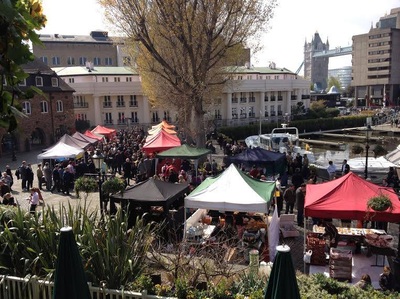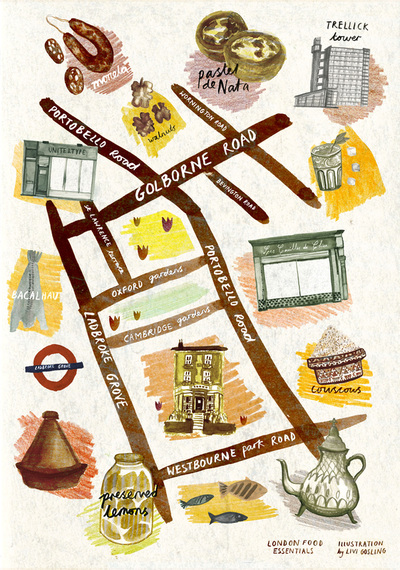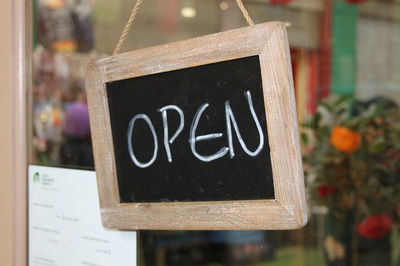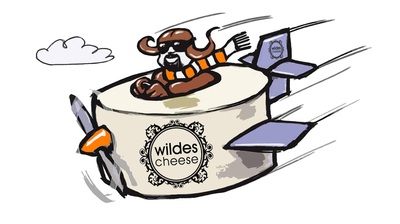My London: John Shepherd of Shepherds Markets
Words by Fiona Symington. Photos courtesy of Shepherds Markets
MAY 2014.
MAY 2014.
In London, everyone knows of Shepherds Markets. On any given day of the week, one of their seventeen markets will be open offering some of the best quality produce and diversity of food producers in the capital.
At the heart of the markets is the Shepherd family. Since launching their first and arguably best known market Duke of York Square in 2005, John Shepherd and his three daughters have changed the market culture of London and arguably paved the way for London’s ever burgeoning street food scene.
Many of the city’s most successful food artisans have a stall at Shepherds — Pieminister, Wildes Cheese, Cutter & Squidge, Cobble Lane Cured to just name a few. More recently, the Shepherds have added a new market – its startisan market at One New Change. This now regular market provides an all-important start for the capital’s newest generation of budding food entrepreneurs and artisans.
Champions of fine foods and local producers, enthusiastic about their traders, and the importance of markets for London, it was our privilege to interview John Shepherd and one of his daughters, Kitty.
Shepherds Market is a family business - when did it all start?
I’ve long been involved in a business started by my brother, of which the best known is Partridges in Duke of York Square. We have been running that now for 42 years. When we moved from Sloane Street to our current location about ten years ago, it became clear that we needed to drive footfall to what was then the first new square in London for 100 years. So in 2005, we started running our first food market. It was small at first but is now 70–80 stalls strong. From there we went to The Brunswick in 2008 and now we have seventeen regular markets across London.
What is the philosophy behind the markets?
We are an independent food business and we select traders with a great deed of care. Our mission is to celebrate London as an open city of authentic, diverse and community-building food markets. So what this means is that we want to work with people who are as concerned about the markets as we are, its community benefits, and who are dedicated to producing good quality food. This is very important to us as we want to call ourselves the good food market.
How do you select the traders that you work with?
We get a lot of people applying and we’re often asked — what can I make so that I can join the market? It’s not that simple. For us it is about finding producers that are doing something unique and different. So one of our traders Giovanni Carleschi of Seriously Italian makes pasta using British durum wheat. We have Chango Empanadas that at the time they joined us were very new. They have recently opened a store in Richmond. Deeney’s who make a Macbeth haggis toastie is another producer that comes to mind. We want all of our traders to do well and that requires a lot of attention to detail from my wife Maria and son-in-law, Janak. Maria really has the eye for spotting new startisans and giving them a chance. This is the term we use to describe people that are just launching their business like Piddington Jam who is here today.
What is the range of produce I’m likely to find at any of your markets?
We have a market every day of the week and I’m quoting Maria my wife here when I say that we are a “three-dimensional market”. Our markets feature street food, artisan produce as well as crafts. This approach means we can go to different locations and do different things. So in April we had a chocolate market at Duke of York Square. The whole area is named after Sir Hans Sloane and he was the first person to bring chocolate back from the West Indies, I think 325 years ago. For the RHS Chelsea Flower Show in May, we are hosting a Floral Feasts market at Duke of York Square as a part of Chelsea in Bloom.
How has London as a food city changed?
Since we started the Partridges food market eight years ago, the quality of food in London has definitely changed — it is much better. There was Borough Market but generally the quality of street markets was not very good. The pitches were generational — most passed from father to son and had really declined. London Farmers’ Markets were relatively new and were giving farmers the opportunity to sell directly to the public. We took that one step further by inviting not just farmers but artisans to sell. More recently, twitter has changed our food culture. You can launch quite a serious business very quickly now and promote it using social media. Markets only complement that.
Why are markets so important to a city like London?
We want to add to the richness of London by utilising spaces throughout the city like the glass canopy of 55 Baker Street so that you can turn a corner and find interesting, locally produced food that you want to eat. Markets have always been a part of London. Near us is Cheapside, which was the oldest market in London. Markets are about returning to something very human. When you produce your own food you talk about it with a knowledge and passion that nobody else can match. So listening is not only fascinating but also an education. It adds to who we are as a city.
What advice you offer to a startisan?
Stick to your original vision and be prepared to persist. Make connections with your fellow traders as they will tell you about other good food markets that you potentially haven’t heard of. It is about finding a market that is going to work for you and this could be a quieter market. For example, City & Country Farmers’ Markets have some very good locations in the suburbs like Herne Hill and Oval. In terms of networks, we talk a lot about the importance of families and family support. You need that back-up system. Also remember the climate around the markets in this country is challenging; so six months of the year it is windy and rains.
You can find one of Shepherds Markets across London. They are currently redeveloping their website that should be available next week but you can read about their latest news and events and get their locations details on Facebook and twitter.
At the heart of the markets is the Shepherd family. Since launching their first and arguably best known market Duke of York Square in 2005, John Shepherd and his three daughters have changed the market culture of London and arguably paved the way for London’s ever burgeoning street food scene.
Many of the city’s most successful food artisans have a stall at Shepherds — Pieminister, Wildes Cheese, Cutter & Squidge, Cobble Lane Cured to just name a few. More recently, the Shepherds have added a new market – its startisan market at One New Change. This now regular market provides an all-important start for the capital’s newest generation of budding food entrepreneurs and artisans.
Champions of fine foods and local producers, enthusiastic about their traders, and the importance of markets for London, it was our privilege to interview John Shepherd and one of his daughters, Kitty.
Shepherds Market is a family business - when did it all start?
I’ve long been involved in a business started by my brother, of which the best known is Partridges in Duke of York Square. We have been running that now for 42 years. When we moved from Sloane Street to our current location about ten years ago, it became clear that we needed to drive footfall to what was then the first new square in London for 100 years. So in 2005, we started running our first food market. It was small at first but is now 70–80 stalls strong. From there we went to The Brunswick in 2008 and now we have seventeen regular markets across London.
What is the philosophy behind the markets?
We are an independent food business and we select traders with a great deed of care. Our mission is to celebrate London as an open city of authentic, diverse and community-building food markets. So what this means is that we want to work with people who are as concerned about the markets as we are, its community benefits, and who are dedicated to producing good quality food. This is very important to us as we want to call ourselves the good food market.
How do you select the traders that you work with?
We get a lot of people applying and we’re often asked — what can I make so that I can join the market? It’s not that simple. For us it is about finding producers that are doing something unique and different. So one of our traders Giovanni Carleschi of Seriously Italian makes pasta using British durum wheat. We have Chango Empanadas that at the time they joined us were very new. They have recently opened a store in Richmond. Deeney’s who make a Macbeth haggis toastie is another producer that comes to mind. We want all of our traders to do well and that requires a lot of attention to detail from my wife Maria and son-in-law, Janak. Maria really has the eye for spotting new startisans and giving them a chance. This is the term we use to describe people that are just launching their business like Piddington Jam who is here today.
What is the range of produce I’m likely to find at any of your markets?
We have a market every day of the week and I’m quoting Maria my wife here when I say that we are a “three-dimensional market”. Our markets feature street food, artisan produce as well as crafts. This approach means we can go to different locations and do different things. So in April we had a chocolate market at Duke of York Square. The whole area is named after Sir Hans Sloane and he was the first person to bring chocolate back from the West Indies, I think 325 years ago. For the RHS Chelsea Flower Show in May, we are hosting a Floral Feasts market at Duke of York Square as a part of Chelsea in Bloom.
How has London as a food city changed?
Since we started the Partridges food market eight years ago, the quality of food in London has definitely changed — it is much better. There was Borough Market but generally the quality of street markets was not very good. The pitches were generational — most passed from father to son and had really declined. London Farmers’ Markets were relatively new and were giving farmers the opportunity to sell directly to the public. We took that one step further by inviting not just farmers but artisans to sell. More recently, twitter has changed our food culture. You can launch quite a serious business very quickly now and promote it using social media. Markets only complement that.
Why are markets so important to a city like London?
We want to add to the richness of London by utilising spaces throughout the city like the glass canopy of 55 Baker Street so that you can turn a corner and find interesting, locally produced food that you want to eat. Markets have always been a part of London. Near us is Cheapside, which was the oldest market in London. Markets are about returning to something very human. When you produce your own food you talk about it with a knowledge and passion that nobody else can match. So listening is not only fascinating but also an education. It adds to who we are as a city.
What advice you offer to a startisan?
Stick to your original vision and be prepared to persist. Make connections with your fellow traders as they will tell you about other good food markets that you potentially haven’t heard of. It is about finding a market that is going to work for you and this could be a quieter market. For example, City & Country Farmers’ Markets have some very good locations in the suburbs like Herne Hill and Oval. In terms of networks, we talk a lot about the importance of families and family support. You need that back-up system. Also remember the climate around the markets in this country is challenging; so six months of the year it is windy and rains.
You can find one of Shepherds Markets across London. They are currently redeveloping their website that should be available next week but you can read about their latest news and events and get their locations details on Facebook and twitter.
Discover more of London
|
FOOD WALKS
Discover all that London has to offer using one of our self-guided food walks. Simply download one of our free PDFs and start walking to find all there is to eat, drink, cook and ware across the city. READ MORE |
LONDON LARDER
Discover the diversity of London's food larder from its markets, beekeepers, coffee roasters, and grocers. All proud Londoners and contributing to the vibrant food culture that is London. READ MORE. |
MY LONDON
We speak to London's local food producers and artisans like the pictured Wildes Cheeses to give you an insider's view of London. READ MORE |





